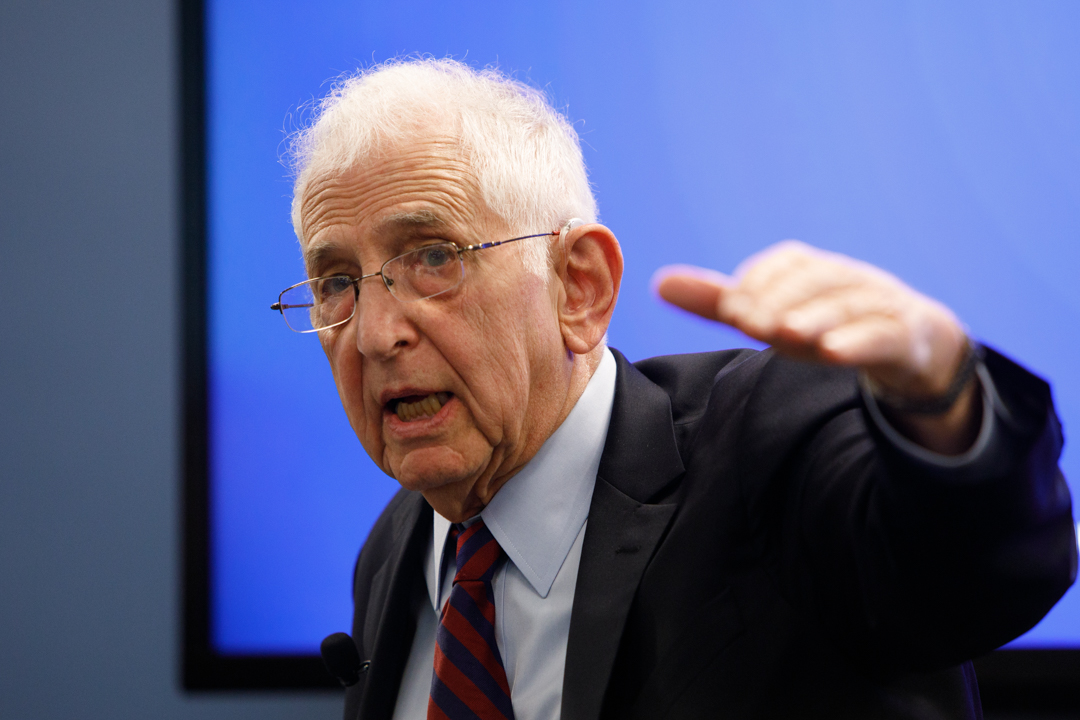By B.L. Wilson
The only thing preventing the annihilation of people on planet Earth is the nuclear capabilities of the United States and Russia, according to Daniel Ellsberg, who is credited with releasing the so-called Pentagon papers in the early 1970s.
In his latest book, “The Doomsday Machine: Confessions of a Nuclear War Planner,” Dr. Ellsberg describes the doomsday machine as an ultimate deterrent against a nuclear attack—a system thought up by Herman Kahn, a colleague at the Rand Corporation. The aim was to prevent an attack against the United States with bombs programmed to destroy all life on earth if triggered by a provocative act. It was suggested as a simpler and cheaper alternative to trying to hit targets thousands of miles away in what was then the Soviet Union.
“No one had built such a system or would build one in his opinion. It was just a conceptual idea,” Dr. Ellsberg said. “Well, Herman was wrong. There was a doomsday machine then, the only one in the world. There would be two later.”
The intercontinental ballistic missiles (ICBMs) the United States built, Russia has since duplicated.
Much of this has been known for sometime. The discussion by Dr. Ellsberg at the George Washington University Elliott School of International Affairs Tuesday was about the miscalculations that led to the ethical quandary of current nuclear deterrence policies.
The event was cosponsored by the Elliott School’s Partnership for International Studies in Asia (PISA); the Leadership, Ethics and Practice Initiative; and the Nuclear Security Working Group.
Welcoming Dr. Ellsberg, Linda Yarr, director of PISA and research professor of practice of international affairs, credited him with “the brave release” of the Pentagon papers “that were indispensable to our understanding of the genesis of the Vietnam War.”
Janne Nolan, research professor of international affairs and chair of the Nuclear Security Work Group at GW, moderated the discussion. She opened by stressing to students in the audience the importance of ethics, noting that it is not a question of whether they would face ethical tests but when.
At the time of the Cuban Missile Crisis in 1962, Dr. Ellsberg explained, the Joint Chiefs estimated that 600 million people would be killed by a nuclear strike on the Soviet Union. That was about a fifth of the world’s population and did not include fatalities caused by any retaliation by the Soviets.
The Soviet Union threatened that it had thousands of missiles. The CIA put the estimate at more like 150. In reality, the Russians had just four.
“It turns out, by the best computations we have now, [a nuclear strike by the United States] would have killed nearly everyone on Earth,” he said.
It was not until 20 years after Dr. Ellsberg had worked on the nuclear plan that he and other scientists such as Carl Sagan, Richard Turco, Alan Robock and Brian Toon understood the full effect of thermonuclear war, the nuclear winter created by the firestorm it would unleash.
“In looking at the consequences of war, they never really figured in fire. . .the main effect of thermonuclear weapons on a large scale,” he said.
In the past 35 years, Dr. Ellsberg said, there has been an effort to eliminate the hair trigger, the response within minutes to the alert of a potential attack, and first use, by leaders of the Strategic Command, the secretary of defense in different administrations, and Presidents Reagan, Carter and Obama, who have said they would not initiate a nuclear war. In reality, funding was increased to rebuild the doomsday machine.
Recently, with President Donald Trump taunting North Korea with a “bigger nuclear button,” the question has been raised whether one person, a president, or one nation should “have the power to end all life on Earth,” he said.
“It is a choice right now, not only in the United States and not only in Russia. We have a serious situation here. It wasn’t created by aliens,” he said.
Dr. Nolan wanted to know what progress had been made in moving from the deterrence paradigm.
Dr. Ellsberg answered that 122 nations have voted to ban nuclear weapons. None of them are nuclear states, and none are members of NATO and as such protected by the U.S. capability.
“We’ve been relying on the threat of carrying out an ultimately insane and immoral strategy, and that’s what we rely on,” he said. “Is it possibly justifiable? It seems to me not.”
He said he’s worried about how close the world has come to nuclear war since 1945. “It’s hard to imagine that we get through another 70 years without this exploding,” he said. “I don’t think our luck will hold out indefinitely.”



